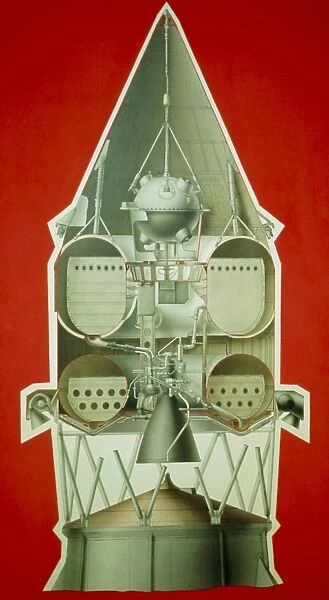Home > Science > Space Exploration > Planets > Mars
Diagram of the Soviet Luna-1 spacecraft
![]()

Wall Art and Photo Gifts from Science Photo Library
Diagram of the Soviet Luna-1 spacecraft
Diagram of the Soviet Luna-1 spacecraft, which became the first artificial " planet" to orbit the Sun following its launch on January 2nd, 1959. Luna-1 was the first of a series of Soviet lunar probes. It passed the Moon at a distance of 6400 kilometres 34 hours after launch & then entered a solar orbit situated between the orbits of Mars & Earth, with a period of 450 days. The spacecraft also created the first artificial " comet" when it ejected a quantity of sodium on January 3, 1959, which could be observed from Earth for several minutes using special filters allowing sodiums characteristic yellow colour to pass. Luna-1 was also known as Meishcha, meaning dream
Science Photo Library features Science and Medical images including photos and illustrations
Media ID 6447329
© RIA NOVOSTI/SCIENCE PHOTO LIBRARY
Exploration Moon Planetary Russian Soviet Space Craft
FEATURES IN THESE COLLECTIONS
> Science
> Space Exploration
> Planets
> Earth
> Science
> Space Exploration
> Planets
> Mars
EDITORS COMMENTS
This print showcases the remarkable Diagram of the Soviet Luna-1 spacecraft, a groundbreaking achievement in space exploration. Launched on January 2nd, 1959, Luna-1 became the first artificial "planet" to orbit the Sun. This momentous event marked a significant milestone for Soviet lunar probes. After just 34 hours since its launch, Luna-1 passed by the Moon at an impressive distance of 6400 kilometers. However, it didn't stop there; instead, it embarked on an extraordinary journey into a solar orbit positioned between Mars and Earth. With a period of 450 days, this spacecraft ventured into uncharted territories. But that's not all! Luna-1 also left another indelible mark in history by creating the world's first artificial "comet". On January 3rd, 1959, it ejected sodium particles into space. These particles emitted a distinct yellow color that could be observed from Earth for several minutes using specialized filters. This breathtaking phenomenon fascinated scientists and enthusiasts alike. Known as Meishcha (meaning dream), Luna-1 symbolizes humanity's relentless pursuit of knowledge and our insatiable curiosity about celestial bodies beyond our own planet. Its successful mission paved the way for future advancements in planetary research and deepened our understanding of outer space. This mesmerizing print from Science Photo Library serves as a testament to human ingenuity and reminds us of how far we have come in exploring the vastness of our universe through scientific endeavors like these
MADE IN AUSTRALIA
Safe Shipping with 30 Day Money Back Guarantee
FREE PERSONALISATION*
We are proud to offer a range of customisation features including Personalised Captions, Color Filters and Picture Zoom Tools
SECURE PAYMENTS
We happily accept a wide range of payment options so you can pay for the things you need in the way that is most convenient for you
* Options may vary by product and licensing agreement. Zoomed Pictures can be adjusted in the Cart.

